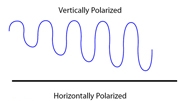Satellite TVRO Part 2

Satellite transponders are simple repeaters that downconvert the incoming signal before rebroadcasting it. There are a limited number of satellites and a limited amount of RF spectrum in which to send and receive these signals, so to overcome these limitations, several methods have been implemented to expand the number of signals that a communication satellite can handle.
Polarization
Each transponder’s frequency band is allowed to overlap the next one, because each transponder has a different polarity than the transponders on either side of it. Using crosspolarity reduces the amount of crosstalk between adjacent transponders and reduces the amount of frequency spectrum required.
Broadcast communication satellites use linear polarity, i.e. horizontal and vertical. But in direct-to-home satellite transmissions, as well as others, circular polarity is the standard where there is right-hand circular polarity (RHCP) and left-hand circular polarity (LHCP). (See Figure 1.)
Switching between polarities provides 20db-40dB of isolation, which allows overlapping frequency bands between crosspolarized transponders. Receiving antennas are aligned to receive signals of one or the other polarity, whether linear or circular. The physical design of the antenna determines which polarity is passed through. For linearly polarized antennas, a motor can move the probe of the antenna and shift it from horizontal to vertical and back again, so one output can present either polarity’s signal. Other linear antennas can supply both polarities at the same time to two different ports. The polarity of a linear antenna must be set precisely to be able to receive the intended polarity.
Circular polarity antennas can be designed for LHCP, RHCP or both, but only one polarity can be delivered to one port; to receive both polarities, two ports are required.
Circular polarization has two main advantages over linear polarization. First, when setting up a receive antenna, there is no alignment of the polarity because the antenna is designed to accept the correct polarity. Second, circularly polarized signals cannot be depolarized. When polarized signals pass through the atmosphere, they can become depolarized, where the off-axis shift of the polarity of the signals (in linearly polarized signals) causes a reduction in the desired polarity and an increase in the opposite polarity, resulting in interference. This effect is most noticeable in the lower-frequency C-band signals. Due to the nature of circularly polarized waves, a rotation of the signal will not affect its reception.
The professional video industry's #1 source for news, trends and product and tech information. Sign up below.
Fractionalized transponders
Normally, a single uplink facility sends a signal up to (illuminates) a satellite transponder, but with precise control, several uplink facilities can transmit to a single transponder. This cuts down on costs and conserves transponder usage. To do this, all the uplink facilities must coordinate with the satellite’s control center and keep the power levels very close. This is very specialized and is not used for normal TV transmissions. (See Figure 2.)
Frequencies
For C-band satellites, the uplink frequencies are 5.925GHz–6.425GHz. Once the satellite’s transponder downconverts the signals, they are downlinked on 3.7MHz–4.2Mhz. Ku-band satellite uplink frequencies are 14GHz–14.5GHz, and the satellite’s transponder downlinks them on 11.7GHz–12.7 GHz. (See Figure 3.)
These signals are received at the antenna and fed into a low-noise block converter where the signal is amplified and mixed with a local oscillator (LO) to produce a lower set of frequencies that will travel a longer distance over coax cable to the receiver or integrated receiver-decoder.
Different LOs are used for different frequency bands, so the resulting frequencies fall into a common band enabling a receiver to use a single intermediate-frequency front-end to receive several different types of satellite signals. That common band for C and Ku is 950MHz-1450Mhz. The LO used for C-band is 5150MHz, and the resulting signals are above the LO. For the Ku-band, the LO is 10750MHz, and the resulting output is below the LO. The stability of the LO can have a great effect on the quality of the signal you receive, or even if you get a signal.
Digital signals
Just as with today’s over-the-air DTV signal that can carry more than one program, so, too, can satellite transmissions. If your station transmits more than one program, then you have two or more encoders whose outputs are combined in a multiplexer and sent on to your digital transmitter. For DTV, we are limited to one 6Mhz-wide channel and the 8-VSB modulation method, which give every station a data rate of 19.4Mb/s. For satellites, a transponder’s bandwidth can be as wide as 70MHz, and the modulation methods have evolved over the years from BPSK and QPSK to SP-QPSK. All these modulation methods provide a higher data rate with which to pass more information within a smaller bandwidth. The “PSK” of all these methods stands for phase shift keying. Binary PSK is where there are only two states of the carrier’s phase, so it can only represent one bit of data, one or zero. Quadrature PSK is where there are four states of the carrier’s phase, which means that it can represent two bits at every state.
Just as in 8-VSB, where there are eight different amplitude levels, each amplitude level represents a single symbol. A symbol corresponds to one of eight possible combinations of three bits, so each symbol sent transmits three bits of data, an eightfold increase of data flow. (See Figure 4.)
8PSK is similar to 8-VSB in that it also has eight different states. One of the newest modulation methods is SP-QPSK (sinusoidal-shaped π/4 QPSK), which is a more efficient way to modulate the satellite carrier and something The Associated Press has just started using.
The symbol rate is the number of symbols sent per second. It contains the data rate and the forward error correction (FEC) data. The symbol and data rates correspond to each other, and a formula can be used to convert between the two. (See Figure 5.)
FEC is an important part of digital broadcasting. In satellite transmissions, the amount of error correction is stated as follows: 1/2, 2/3, 3/4, 7/8. The first number is the number of actual data bits, followed by the total number of bits transmitted. The difference is the amount of error correction bits. So for an FEC of 1/2, there is one error correction bit for data every bit. At the other end, an FEC of 7/8 means there is one error correction bit for every seven data bits.
An FEC of 1/2 equals a great deal of error correction, which will tolerate smaller antennas and lower-quality receive equipment, while an FEC of 7/8 means the signal provider is trying to squeeze as much data through as possible and may require a bigger antenna and higher-quality receive equipment.
Conclusion
All of the methods described allow for more data to be sent through fewer frequencies. Satellite transmission requires a great deal of high-tech equipment to be able to reliably send and receive the programs that TV stations use every day.
Acknowledgements
Frank Foge of CALSAT and Ed Johnson of San Francisco International Gateway Teleport assisted with this tutorial.
Next Time
The next “Transition to Digital” tutorial will discuss how to find the satellite you want.
Continue reading part three of the Satellite TVRO series.
